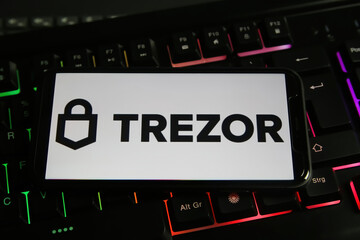
In a disturbing turn of events, the hardware wallet manufacturer Trezor‘s official X account has become the center of attention for all the wrong reasons. A series of malicious postings promoting fraudulent presale token offers have emerged, likely the consequence of a sophisticated SIM-swap attack. This incident has sent ripples through the cryptocurrency community, underscoring the relentless threat landscape even the most reputed entities face.
The Breach Unveiled
Detection and Immediate Response
The suspected security compromise first came to light through the vigilant efforts of independent blockchain investigator, ZachXBT, who alerted his extensive follower base about the anomaly. Shortly after, the crypto security watchdog Scam Sniffer raised alarms, further amplifying concerns over the breach’s authenticity.
The compromised account hawked a non-existent Trezor “$TRZR” presale token purportedly available on the Solana blockchain. Prospective buyers were urged to transfer funds to a designated Solana wallet, unknowingly walking into a trap set with wallet-draining schemes. Additionally, a scheme involving a new memecoin named Slerf on Solana was spotted, seemingly aimed at garnering more attention to the scam.
Financial Repercussions
Minimal Loot with Maximum Audacity
Despite the high-profile nature of the hack, the financial damage was relatively modest, with the perpetrator managing to siphon off approximately $8,100 from Trezor’s Zapper account. This incident provoked commentary on the brazenness of the attack, considering the meager sum obtained and the significant risk undertaken.
Community Reaction and Critique
The breach has not gone without its fair share of criticism from the cryptocurrency community. Notably, John Holmquist lambasted Trezor for its apparent laxity in employing robust security measures such as two-factor authentication (2FA) for its social media handles. This sentiment was echoed by others who found it paradoxical that a company specializing in security solutions would falter in safeguarding its digital presence.
A History of Security Challenges
Prior Breaches and Resilience
This is not Trezor’s first rodeo with security breaches. A notable incident in January had previously exposed the contact details of nearly 66,000 users, putting a spotlight on the ongoing challenges faced by the firm in maintaining the privacy and security of its clientele. Despite these setbacks, Trezor has been a mainstay in the cryptocurrency hardware wallet market since its inception in 2012, boasting over two million units sold.
Product Lineup and Market Presence
A Trusted Name in Cryptocurrency Security
Trezor offers a range of hardware wallets designed to provide secure offline storage for over 9,000 cryptocurrency coins and tokens. Its product lineup caters to a diverse clientele, reinforcing its commitment to offering robust security solutions in the ever-evolving digital asset landscape.
To encapsulate the significant aspects of this incident and Trezor’s standing in the crypto security domain, the following table and bullet points offer a summarized overview:
| Date | Event |
|---|---|
| March 19 | Suspected SIM-swap attack leading to fraudulent postings on Trezor’s X account. |
| Shortly after | Detection and public notification by ZachXBT and Scam Sniffer. |
| Following posts | Promotion of a fictitious “$TRZR” presale and a new memecoin, “Slerf”. |
| January | Previous breach exposing user contact information. |
| 2012-Present | Over two million Trezor wallets sold, supporting more than 9,000 types of cryptocurrencies. |
- The security breach highlights the persistent threat of cyber attacks, even against leading security-focused firms.
- The financial impact of the hack was relatively minor, but the reputational damage and community response underscore the severity of such incidents.
- Criticism from the community focuses on the perceived neglect of basic security practices, such as two-factor authentication.
- Trezor’s history of breaches illustrates the ongoing battle for digital security amidst a landscape fraught with sophisticated threats.
- Despite challenges, Trezor remains a key player in the cryptocurrency hardware wallet market, trusted by millions of users worldwide.
The recent security lapse involving Trezor’s official X account serves as a stark reminder of the cybersecurity challenges that persist in the digital asset industry. It underscores the importance of vigilant security practices, not just in securing financial assets but also in protecting digital footprints against sophisticated cyber threats. As the cryptocurrency landscape continues to evolve, so too must the strategies employed to safeguard against these ever-present dangers.
Featured image credit: Ralf via Adobe Stock
